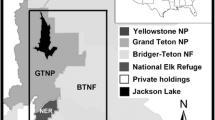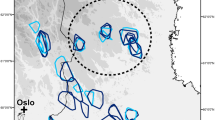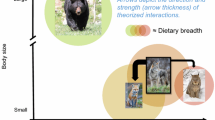Abstract
Resource competition is an important interaction that can structure ecological communities, but is difficult to demonstrate in nature, and rarely demonstrated for large mammals including marsupials. We analysed 10 years of population survey data to investigate resource competition between bare-nosed wombats (Vombatus ursinus) and eastern grey kangaroos (Macropus giganteus) at two sites to assess whether resource competition is occurring. At one site, wombat abundance was reduced by increased mortality from mange disease, whereas at the other site, kangaroo abundance was reduced primarily by culling. We used the modified Lotka–Volterra competition (LVC) models to describe the mechanism of resource competition and fitted those models to the empirical data by maximum likelihood estimation. We found strong negative relationships between the abundance of wombats and kangaroos at each site, and resource competition was also mechanistically supported by the modified LVC models. The estimated competition coefficients indicate that bare-nosed wombats are a slightly superior competitor of eastern grey kangaroos than vice versa, and that intraspecific competition is almost twice as strong as interspecific competition. In addition, this study facilitated the calculation of the transmission rate associated with mange disease at one site (0.011), and the removal rate owing to culling, the introduction of a predator species, and drought at the other site (0.0006). Collectively, this research represents a rare empirical demonstration of resource competition between large mammals and contributes new insight into the ecology of two of Australia’s largest grazing marsupials.




Similar content being viewed by others
References
Adler PB et al (2018) Competition and coexistence in plant communities: intraspecific competition is stronger than interspecific competition. Ecol Lett 21:1319–1329. https://doi.org/10.1111/ele.13098
Altizer S, Dobson A, Hosseini P, Hudson P, Pascual M, Rohani P (2006) Seasonality and the dynamics of infectious diseases. Ecol Lett 9:467–484. https://doi.org/10.1111/j.1461-0248.2005.00879.x
Arman SD, Prideaux GJ (2015) Dietary classification of extant kangaroos and their relatives (Marsupialia: Macropodoidea). Austral Ecol 40:909–922. https://doi.org/10.1111/aec.12273
Banks PB (2001) Predation-sensitive grouping and habitat use by eastern grey kangaroos: a field experiment. Anim Behav 61:1013–1021. https://doi.org/10.1006/anbe.2001.1686
Beeton NJ, Carver S, Forbes LK (2019) A model for the treatment of environmentally transmitted sarcoptic mange in bare-nosed wombats (Vombatus ursinus). J Theor Biol 462:466–474. https://doi.org/10.1016/j.jtbi.2018.11.033
Bureau of Meteorology (2020) Average annual, seasonal and monthly rainfall: Maria Island (Point Lesueur). Accessed 13 Dec 2020
Carricondo-Sanchez D, Odden M, Linnell JDC, Odden J (2017) The range of the mange: Spatiotemporal patterns of sarcoptic mange in red foxes (Vulpes vulpes) as revealed by camera trapping. PLoS ONE 12:e0176200. https://doi.org/10.1371/journal.pone.0176200
Carver S, Charleston M, Hocking G, Gales R, Driessen MM (2021) Long-term spatiotemporal dynamics and factors associated with trends in bare-nosed wombats. J Wildl Manag 85:449–461. https://doi.org/10.1002/jwmg.22014
Caughley G, Grigg GC, Smith L (1985) The effect of drought on kangaroo populations. J Wildl Manag 49:679–685. https://doi.org/10.2307/3801694
Chesson P (2000) Mechanisms of maintenance of species diversity. Annu Rev Ecol Syst 31:343–366. https://doi.org/10.1146/annurev.ecolsys.31.1.343
Davis NE, Coulson G, Forsyth DM (2008) Diets of native and introduced mammalian herbivores in shrub-encroached grassy woodland, south-eastern Australia. Wildl Res 35:684–694. https://doi.org/10.1071/Wr08042
Davis NE, Gordon IR, Coulson G (2017) The influence of evolutionary history and body size on partitioning of habitat resources by mammalian herbivores in south-eastern Australia. Aust J Zool 65:226–239. https://doi.org/10.1071/Zo16075
Dawson TJ (2012) Kangaroos, 2nd edn. CSIRO Publishing, VIC Australia
Devenish-Nelson ES, Richards SA, Harris S, Soulsbury C, Stephens PA (2014) Demonstrating frequency-dependent transmission of sarcoptic mange in red foxes. Biol Lett 10:20140524. https://doi.org/10.1098/rsbl.2014.0524
Dickman CR (1986a) An experimental manipulation of the intensity of interspecific competition: effects on a small marsupial. Oecologia 70:536–543. https://doi.org/10.1007/bf00379900
Dickman CR (1986b) An experimental study of competition between two species of dasyurid marsupials. Ecol Monogr 56:221–241. https://doi.org/10.2307/2937075
Dickman CR, Woodside DP (1983) A test of a competition model with reference to 3 species of small mammals in southeastern Australia. Oecologia 60:127–134. https://doi.org/10.1007/Bf00379332
Evans MC (2008) Home range, burrow-use and activity patterns in common wombats (Vombatus ursinus). Wildl Res 35:455. https://doi.org/10.1071/wr07067
Evans MC, Jarman P, Green B (2000) Ecological energetics of wombats. Ph.D. thesis, University of New England
Evans M, Green B, Newgrain K (2003) The field energetics and water fluxes of free-living wombats (Marsupialia: Vombatidae). Oecologia 137:171–180. https://doi.org/10.1007/s00442-003-1322-4
Evans MC, Macgregor C, Jarman PJ (2006) Diet and feeding selectivity of common wombats. Wildl Res 33:321–330. https://doi.org/10.1071/Wr05047
Fleming PA, Anderson H, Prendergast AS, Bretz MR, Valentine LE, Hardy GES (2014) Is the loss of Australian digging mammals contributing to a deterioration in ecosystem function? Mammal Rev 44:94–108. https://doi.org/10.1111/mam.12014
Fort H, Segura A (2018) Competition across diverse taxa: quantitative integration of theory and empirical research using global indices of competition. Oikos 127:392–402. https://doi.org/10.1111/oik.04756
Gause GF (1934) Experimental analysis of Vito Volterra’s mathematical theory of the struggle for existence. Science 79:16–17. https://doi.org/10.1126/science.79.2036.16-a
Gill DE (1974) Intrinsic rate of increase, saturation density, and competitive ability. 2. Evolution of competitive ability. Am Nat 108:103–116. https://doi.org/10.1086/282888
Harper D, Horsup A (2018) A summary for the northern hairy-nosed wombat Lasiorhinus krefftii. Department of Environment and Science, Queensland Government, Brisbane, Australia
Hethcote HW (1976) Qualitative analyses of communicable disease models. Math Biosci 28:335–356
Hethcote HW (1989) Three basic epidemiological models. In: Levin SA, Hallam TG, Gross LJ (eds) Applied mathematical ecology, 1st edn. Springer, Berlin , pp 119–144
Howland B, Stojanovic D, Gordon IJ, Manning AD, Fletcher D, Lindenmayer DB (2014) Eaten out of house and home: impacts of grazing on ground-dwelling reptiles in Australian grasslands and grassy woodlands. PLoS ONE 9:e105966. https://doi.org/10.1371/journal.pone.0105966
Ingram J (2018) An adaptive management case study for managing macropods on Maria Island National Park, Tasmania, Australia: adding devils to the detail. Pac Conserv Biol 24:108–121. https://doi.org/10.1071/PC17045
Le Mar K, McArthur C (2005) Comparison of habitat selection by two sympatric macropods, Thylogale billardierii and Macropus rufogriseus rufogriseus, in a patchy eucalypt-forestry environment. Austral Ecol 30:674–683. https://doi.org/10.1111/j.1442-9993.2005.01510.x
Levine JM, Bascompte J, Adler PB, Allesina S (2017) Beyond pairwise mechanisms of species coexistence in complex communities. Nature 546:56–64. https://doi.org/10.1038/nature22898
Lotka AJ (1920) Analytical note on certain rhythmic relations in organic systems. Proc Natl Acad Sci USA 6:410–415. https://doi.org/10.1073/pnas.6.7.410
Lunney D, Purcell B, McLeod S, Grigg G, Pople T, Wolter S (2018) Four decades of research and monitoring the populations of kangaroos in New South Wales: One of the best long-term datasets in Australia. Aust Zool 39:784–800. https://doi.org/10.7882/AZ.2018.040
Luo J, Monamy V, Fox BJ (1998) Competition between two Australian rodent species: a regression analysis. J Mammal 79:962–971. https://doi.org/10.2307/1383104
Martin AM, Burridge CP, Ingram J, Fraser TA, Carver S (2017) Invasive pathogen drives host population collapse: effects of a travelling wave of sarcoptic mange on bare-nosed wombats. J Appl Ecol 55:331–341. https://doi.org/10.1111/1365-2664.12968
Martin AM, Richards SA, Fraser TA, Polkinghorne A, Burridge CP, Carver S (2019) Population-scale treatment informs solutions for control of environmentally transmitted wildlife disease. J Appl Ecol 56:2363–2375. https://doi.org/10.1111/1365-2664.13467
McIntyre S et al (2010) Biomass and floristic patterns in the ground layer vegetation of box-gum grassy eucalypt woodland in Goorooyarroo and Mulligans Flat Nature Reserves, Australian Capital Territory. Cunninghamia 11:319–357
Monterroso P, Francisco DR, Lukacs PM, Alves PC, Ferreras P (2020) Ecological traits and the spatial structure of competitive coexistence among carnivores. Ecology 101:e03059. https://doi.org/10.1002/ecy.3059
Morgan C, Shipley ON, Gelsleichter J (2020) Resource-use dynamics of co-occurring chondrichthyans from the First Coast, North Florida, USA. J Fish Biol 96:570–579. https://doi.org/10.1111/jfb.14238
Mougi A, Kondoh M (2012) Diversity of interaction types and ecological community stability. Science 337:349–351. https://doi.org/10.1126/science.1220529
Munn AJ, Kalkman L, Skeers P, Roberts JA, Bailey J, Dawson TJ (2016) Field metabolic rate, movement distance, and grazing pressures by western grey kangaroos (Macropus fuliginosus melanops) and Merino sheep (Ovis aries) in semi-arid Australia. Mamm Biol 81:423–430. https://doi.org/10.1016/j.mambio.2016.04.001
Myung IJ (2003) Tutorial on maximum likelihood estimation. J Math Psychol 47:90–100. https://doi.org/10.1016/s0022-2496(02)00028-7
Pearse RJ (1981) Notes on breeding, growth and longevity of the Forester or eastern grey kangaroo, Macropus giganteus Shaw, in Tasmania. Aust Wildl Res 8:229–235. https://doi.org/10.1071/WR9810229
Prins HHT (2000) Competition between wildlife and livestock in Africa. In: Prins HHT, Grootenhuis JG, Dolan TT (eds) Wildlife conservation by sustainable use, 1st edn. Springer, Netherlands, pp 51–80
Putman R (1996) Factors structuring resource relationships in ungulate assemblies. In: Putman R (ed) Competition and resource partitioning in temperate ungulate assemblies, vol 3, 1st edn. Springer, Netherlands
R Development Core Team (2020) R: a language and environment for statistical computing. R Foundation for Statistical Computing, Vienna, Austria
Remonti L, Balestrieri A, Ruiz-González A, Gómez-Moliner BJ, Capelli E, Prigioni C (2012) Intraguild dietary overlap and its possible relationship to the coexistence of mesocarnivores in intensive agricultural habitats. Popul Ecol 54:521–532. https://doi.org/10.1007/s10144-012-0326-5
Robertson G (1986) The mortality of kangaroos in drought. Wildl Res 13:349–354. https://doi.org/10.1071/wr9860349
Roslin T, Traugott M, Jonsson M, Stone GN, Creer S, Symondson WOC (2019) Introduction: Special issue on species interactions, ecological networks and community dynamics—untangling the entangled bank using molecular techniques. Mol Ecol 28:157–164. https://doi.org/10.1111/mec.14974
Ruykys L, Breed B, Schultz D, Taggart D (2013) Effects and treatment of sarcoptic mange in southern hairy-nosed wombats (Lasiorhinus latifrons). J Wildl Dis 49:312–320. https://doi.org/10.7589/2012-10-256
Seibold S, Cadotte MW, MacIvor JS, Thorn S, Muller J (2018) The necessity of multitrophic approaches in community ecology. Trends Ecol Evol 33:754–764. https://doi.org/10.1016/j.tree.2018.07.001
Soetaert KE, Petzoldt T, Setzer RW (2010) Solving differential equations in R: package deSolve. J Stat Softw 33:1–25. https://doi.org/10.18637/jss.v033.i09
Southwell C (1987) Activity pattern of the eastern gray kangaroo, Macropus giganteus. Mammalia 51:211–223. https://doi.org/10.1515/mamm.1987.51.2.211
Sprent JA, McArthur C (2002) Diet and diet selection of two species in the macropodid browser-grazer continuum: do they eat what they ‘should’? Aust J Zool 50:183–192. https://doi.org/10.1071/Zo01043
Tanner Z, Hocking G (2001) Status and management of the forester kangaroo in Tasmania, 2000. Nature Conservation Branch, Department of Primary Industries, Water and Environment, Tasmanian Government, Hobart, Tasmania
Thalmann S, Peck S, Wise P, Potts JM, Clarke J, Richley J (2016) Translocation of a top-order carnivore: tracking the initial survival, spatial movement, home-range establishment and habitat use of Tasmanian devils on Maria Island. Aust Mammal 38:68–79. https://doi.org/10.1071/Am15009
Thomas L et al (2010) Distance software: design and analysis of distance sampling surveys for estimating population size. J Appl Ecol 47:5–14. https://doi.org/10.1111/j.1365-2664.2009.01737.x
Triggs B (2009) Wombats, 2nd edn. CSIRO Publishing, VIC Australia
Volterra V (1926) Variazioni e fluttuazioni del numero d’individui in specie animali conviventi. Memoria Della Reale Accademia Nazionale Dei Lincei 2:31–113
Wahungu G (1998) Diet and habitat overlap in two sympatric primate species, the Tana crested mangabey Cercocebus galeritus and yellow baboon Papio cynocephalus. Afr J Ecol 36:159–173. https://doi.org/10.1046/j.1365-2028.1998.00120.x
Wilkinson V et al (2021) Fluralaner as a novel treatment for sarcoptic mange in the bare-nosed wombat (Vombatus ursinus): safety, pharmacokinetics, efficacy and practicable use. Parasit Vectors. https://doi.org/10.1186/s13071-020-04500-9
Wise P, Peck S, Clarke J, Hogg CJ (2019) Conservation introduction of Tasmanian devils to Maria Island: a managed response to DFTD. In: Hogg CJ, Fox S, Pemberton D, Belov K (eds) Saving the Tasmanian devil: Recovery through science based management. CSIRO Publishing, pp 207–220
Woolnough AP, Johnson CN (2000) Assessment of the potential for competition between two sympatric herbivores - the northern hairy-nosed wombat, Lasiorhinus krefftii, and the eastern grey kangaroo, Macropus giganteus. Wildl Res 27:301–308. https://doi.org/10.1071/Wr99053
Wootton JT (1994) The nature and consequences of indirect effects in ecological communities. Annu Rev Ecol Syst 25:443–466. https://doi.org/10.1146/annurev.es.25.110194.002303
Xiong J, Li X, Wang H (2019) Global asymptotic stability of a Lotka–Volterra competition model with stochasticity in inter-specific competition. Appl Math Lett 89:58–63. https://doi.org/10.1016/j.aml.2018.09.018
Acknowledgements
We would like to thank the Tasmanian Government Department of Primary Industries, Parks, Wildlife and Environment and the Tasmanian Parks and Wildlife Service for their support and cooperation of this work. We also thank the many undergraduate volunteers who have assisted with these surveys.
Funding
This project was partly funded by the Holsworth Wildlife Research Endowment; Cradle Coastal Authority; Australian Research Council Linkage Project (LP180101251).
Author information
Authors and Affiliations
Contributions
SC, CB and JT conceived the idea. All the authors collected the data at Narawntapu National Park and JI provided the data of Point Lesueur. SC and JT created the mechanistic models. JT wrote the manuscript; the other authors provided editorial advice.
Corresponding author
Ethics declarations
Conflict of interest
The authors declare that they have no conflict of interest.
Ethics approval
This project was carried out under University of Tasmania Animal Ethic Approval A14670 and A0018662.
Consent to participate
All the authors approved to participate in this study.
Consent for publication
All the authors approved for the publication of this study.
Additional information
Communicated by Graeme Shannon.
We believe this study is suited to be published as the Highlighted Student Papers. Shows competitive relationship between two large wild mammals—difficult for ethical issues and inability of manipulating wild populations—adding knowledge of population trends in an ecosystem
Supplementary Information
Below is the link to the electronic supplementary material.
Rights and permissions
About this article
Cite this article
Tamura, J., Ingram, J., Martin, A.M. et al. Contrasting population manipulations reveal resource competition between two large marsupials: bare-nosed wombats and eastern grey kangaroos. Oecologia 197, 313–325 (2021). https://doi.org/10.1007/s00442-021-04959-y
Received:
Accepted:
Published:
Issue Date:
DOI: https://doi.org/10.1007/s00442-021-04959-y




